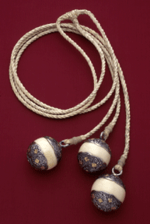Bolas
A bolas (plural: bolas or bolases; from Spanish bola, "ball", also known as boleadoras) is a type of throwing weapon made of weights on the ends of interconnected cords, used to capture animals by entangling their legs. Bolas were most famously used by the gauchos (South American cowboys), but have been found in excavations of Pre-Columbian settlements, especially in Patagonia, where indigenous peoples (particularly the Tehuelche) used them to catch 200-pound guanaco (llama-like mammals) and ñandú (birds). The Mapuche and the Inca army used them in battle. Researchers have also found bolas in North America at the Calico Early Man Site.
| Bola | |
|---|---|
.jpg) A hunter using bolas while mounted on a horse. | |
| Type | Throwing weapon |
| Place of origin | The Americas |
Use

Gauchos used boleadoras to capture running cattle or game. Depending on the exact design, the thrower grasps the boleadora by one of the weights or by the nexus of the cords. The thrower gives the balls momentum by swinging them and then releases the boleadora. The weapon is usually used to entangle the animal's legs, but when thrown with enough force might even inflict damage (e.g. breaking a bone).
Traditionally, Inuit have used bolas to hunt birds, fouling the birds in air with the lines of the bola. People of a Feather showed Belcher Island Inuit using bolas to hunt eider ducks on the wing.[1]
Design

There is no uniform design; most bolas have two or three balls, but there are versions of up to eight or nine. Some bolas have balls of equal weight, others vary the knot and cord. Gauchos use bolas made of braided leather cords with wooden balls or small leather sacks full of stones at the ends of the cords.
Bolas can be named depending on the number of weights used:
- Perdida (one weight)
- Avestrucera or ñanducera (two weights, for rheas)
- Somai (two weights)[2]
- Achico (three weights)[2]
- Boleadora (three weights)
- Kiipooyaq (Inuit name for bolas with three or more weights[3][4])
Bolas of three weights are usually designed with two shorter cords with heavier weights, and one longer cord with a light weight. The heavier weights fly at the front parallel to each other, hit either side of the legs, and the lighter weight goes around, wrapping up the legs.

Other unrelated versions include qilumitautit, the bolas of the Inuit, made of sinew and bone weights and used to capture water birds.
See also
- BolaWrap, contemporary version used by police
- Arctic yo-yo
- Bolas spiders, which swing a sticky web blob at the end of a web line to capture prey
- Bolo tie, a style of necktie resembling the bolas in that it has weights at the end of a string
- Lasso or lariat, a looped rope used for similar purposes, especially in North America
- Meteor hammer and meteor (juggling)
- Poi
References
- Tracy Allard (8 November 2013). "People of a Feather (2011)". IMDb. Retrieved 21 November 2014.
- Blair, Claude and Tarassuk, Leonid, eds. (1982). The Complete Encyclopedia of Arms and Weapons. p. 92. Simon & Schuster. ISBN 0-671-42257-X.
- "Inuit Bola". Gamesmuseum.uwaterloo.ca. Archived from the original on 8 November 2014. Retrieved 21 November 2014.
- Archived July 9, 2008, at the Wayback Machine
External links
| Look up bolas in Wiktionary, the free dictionary. |
| Wikimedia Commons has media related to Bolas. |